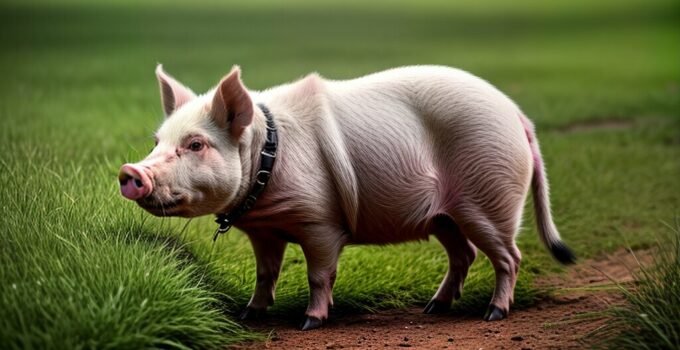If you’re considering getting a pet pig, it’s important to understand that housebreaking can be a challenge. However, with the right training methods and consistency, it is definitely achievable. Here’s a list of training methods for housebreaking a pig! This article will guide you through the process of housebreaking your pet pig and provide you with the best training techniques to ensure success.
Key Takeaways:
Effective housebreaking of a pig requires understanding of pig behavior and learning.
Establishing a consistent routine and clear boundaries is important for successful housebreaking.
Crate training and positive reinforcement are effective methods for housebreaking a pig.
Consistency and patience are crucial for the housebreaking process.
Socialization and enrichment are important for a well-rounded pig.
Understanding Pig Behavior and Learning
When it comes to housebreaking a pig, it’s important to understand their behavior and learning process. Pigs are highly intelligent and social animals, and they respond well to positive reinforcement training methods.
One effective method for training a pig to use a litter tray is to take advantage of their natural instincts. Pigs have a natural inclination to root and dig, and this can be used to encourage them to use a designated spot for elimination. Place a small amount of dirt or sand in the litter tray and show the pig where it is. They will likely start using it on their own with some reinforcement.
Positive Reinforcement Training for Pigs
Positive reinforcement is a highly effective method for training pigs. This involves offering rewards and praise for good behavior, rather than punishing undesirable behavior. You can use treats, verbal cues, and clicker training to reinforce the desired behavior during housebreaking.
When using positive reinforcement, it’s important to offer the reward immediately after the desired behavior is exhibited. This reinforces the connection between the behavior and the reward in the pig’s mind. It’s also important to use consistent verbal cues and hand signals to help the pig understand what is expected of them.
Crate Training for Housebreaking
Crate training can be an effective tool when housebreaking a pig. A crate provides a safe and comfortable space for the pig to sleep and relax, and it can also be used to encourage good bathroom habits. Start by introducing the crate as a positive space, with treats and toys inside. Gradually increase the time the pig spends in the crate, and only let them out when they are calm and quiet.
It’s important to never use the crate as a punishment, and to make sure it’s the appropriate size for the pig. The crate should be big enough for the pig to stand up, turn around, and lay down comfortably. With consistent use, the crate can become a valuable part of the pig’s housebreaking routine.
Establishing a Routine
Effective housebreaking relies on establishing a consistent routine for your pig. Setting a clear schedule for feeding, bathroom breaks, and training sessions can help your pig learn quickly and develop good habits.
One of the most important things to keep in mind when establishing a routine is to be consistent with your expectations and training methods. Pigs thrive on routine and repetition, so try to keep your training sessions at the same time each day and in the same location.
It’s also essential to set clear boundaries and expectations for your pig. Decide where you want your pig to go potty and communicate that to your pet. Take your pig to the designated spot regularly and encourage your pet to go potty there with rewards and praise.
Additionally, be sure to monitor your pig’s behavior and adjust the routine accordingly. If your pig is struggling with a certain aspect of housebreaking, try changing the routine or adjusting your training methods.
Overall, establishing a consistent routine is a critical aspect of successful pig housebreaking. With patience and persistence, your pet will learn good bathroom habits and become a happy and well-trained companion.
Crate Training
Crate training can be a valuable tool in housebreaking a pig. A crate provides a safe and comfortable space for the pig to rest and sleep, and can also serve as a designated potty area. Here are some steps to follow when crate training your pig:
- Choose the right size crate. The crate should be large enough for the pig to stand up and turn around in, but not so big that it can use one end as a bathroom and the other for sleeping.
- Introduce the crate slowly. Start by placing treats and toys inside the crate to entice the pig to go in. Gradually increase the amount of time the pig spends in the crate, starting with short intervals.
- Use positive reinforcement. Whenever the pig goes into the crate voluntarily, offer verbal praise and treats. This will encourage the pig to associate the crate with positive experiences.
- Establish a routine. Use the crate consistently for napping and bedtime, as well as for potty breaks. This will help the pig to learn when it’s time to go to the bathroom.
- Be patient. It may take time for the pig to adjust to the crate and learn to use it as a potty area. Don’t punish the pig if it has accidents outside the crate, but instead, praise it when it uses the crate as intended.
Crate training can be an effective way to teach a pig to be housebroken, but it’s important to use it in combination with other positive reinforcement training methods.
Positive Reinforcement Training
Positive reinforcement training is a highly effective method for housebreaking pigs. This approach involves rewarding the pig for displaying good behavior, rather than punishing them for making mistakes. The key to success with positive reinforcement training is consistency and patience.
One popular technique is clicker training, which involves using a clicker to mark the desired behavior and then immediately rewarding the pig with a treat. Verbal cues, such as “go potty” or “use the litter box,” can also be introduced to reinforce the desired behavior.
It’s important to only reward the pig when they display the desired behavior. This helps to reinforce the connection between the behavior and the reward. Consistency is also key, so it’s important to use the same rewards and cues every time.
Treats should be small and easily digestible, such as small pieces of carrot or apple. It’s important not to overfeed the pig with treats, as this can lead to weight gain and health problems.
Positive reinforcement training can take time, but with patience and consistency, it can be a highly effective method for housebreaking a pig.
Consistency and Patience
When it comes to housebreaking a pig, consistency and patience are key. It’s important to have a clear understanding of the training methods being used and to stick to them consistently. This means establishing a routine and being diligent in following it.
However, it’s important to remember that housebreaking a pig may take time and patience. Pigs, like any animal, will have their own pace of learning and may need extra time and reinforcement. It’s important not to get frustrated or discouraged if progress seems slow.
Consistency also means being patient with the pig. Punishing or scolding the pig will only create fear and anxiety, making the housebreaking process more difficult. Instead, focus on positive reinforcement techniques, rewarding the pig for good behavior and redirecting them when they make mistakes.
Troubleshooting Common Challenges
Housebreaking a pig can present various challenges, but with patience and perseverance, most issues can be resolved. Here are some common challenges and solutions for overcoming them.
Accidents
Accidents can happen, especially in the early stages of housebreaking. It’s important to clean the area thoroughly and avoid scolding the pig, as this can create anxiety and lead to further accidents. Instead, reinforce positive behavior by rewarding the pig when it goes potty in the appropriate location. Increase bathroom breaks and supervision to prevent future accidents.
Resistance to Training
If the pig is resistant to training, it may be due to fear, anxiety, or lack of understanding. To address this, use positive reinforcement techniques and gradually increase the pig’s exposure to the training process. If the pig shows signs of fear or anxiety, take a break and return to training later. Seek professional assistance if needed.
Obstacles
Obstacles such as medical issues, inconsistent training, or changes in the pig’s environment can hinder the housebreaking process. It’s important to address these obstacles as soon as possible and adjust training methods accordingly. Stay consistent with training and seek assistance from a veterinarian or professional trainer if needed.
Socialization and Enrichment
Proper socialization and enrichment are important factors in housebreaking a pig. Exposure to different environments, people, and animals can help develop the pig’s behavior and temperament, making it easier to train them for good habits. Incorporating socialization and enrichment activities into the training routine is an effective way to accelerate the housebreaking process and promote good behavior.
When introducing the pig to new people or animals, it’s important to ensure their safety and comfort. Start with short periods of exposure and gradually increase the duration as the pig becomes more comfortable. Always supervise interactions and use positive reinforcement to encourage good behavior.
Enrichment activities can include toys and puzzles that stimulate the pig’s natural instincts and behaviors. Providing them with different textures, sounds, and scents can also be beneficial. Activities that require problem-solving or physical activity can help keep the pig mentally and physically stimulated.
It’s important to note that each pig is unique and may have different needs when it comes to socialization and enrichment. Pay attention to their behavior and preferences and adjust the routine accordingly. With proper socialization and enrichment, you can help your pig develop good habits and strengthen your bond as a pet owner.
Maintaining good habits
Once a pig has been successfully housebroken, it is important for pet owners to maintain good habits. This includes reinforcing training, monitoring the pig’s behavior, and addressing any potential regressions.
Reinforcing training is essential to ensure that the pig continues to follow good housebreaking practices. This can be done by rewarding the pig for good behavior, using positive reinforcement techniques, and avoiding punishment for accidents.
Monitoring the pig’s behavior is also important, as it can help pet owners identify any potential issues early on. This includes monitoring the pig’s eating and drinking habits, bathroom frequency, and overall demeanor.
If a pig does experience a regression in their housebreaking habits, it is important to address it promptly. This can be done by revisiting training techniques, adjusting the pig’s routine, or seeking professional assistance.
Ongoing potty training maintenance is also important to ensure that the pig continues to follow good habits. This includes regular cleaning of litter trays or designated potty areas, monitoring the pig’s food and water intake, and consistent reinforcement of good behavior.
Resources and Further Assistance
Housebreaking a pig can be challenging, but there are plenty of resources available to pet owners who need help. Whether you’re a first-time pig owner or an experienced trainer, these resources can provide invaluable support and guidance.
Literature
There are several books available on pig training and behavior that can help pet owners establish effective housebreaking methods. Some recommended titles include:
- Pig Behavior by Sarah Probst
- The Ultimate Guide to Pig Training by Susan Smith
- Pigs as Pets: A Guide to Keeping Pigs as a Pet by Lolly Brown
Online Resources
There are also several online resources available for pig owners seeking advice and assistance with housebreaking. Some recommended websites include:
- PotbellyPigs.com: A forum for pig owners to share advice and support
- Pig O’ My Heart Potbellies: A website with information on pig behavior, training, and health
- Pig Placement Network: A nonprofit organization that provides resources and support for pig owners
Professional Trainers
If you’re struggling with housebreaking your pig, it may be helpful to seek the assistance of a professional pig trainer. Look for trainers who specialize in pig training and behavior, and who have a proven track record of success. Some recommended trainers include:
- Megan ‘Pinky’ Loeffler at Lovin’ Our Littles Sanctuary
- Julie Steiner at The Pig Preserve
- Charlie and Shannon Rogers at Pig Paradise
Remember, it’s okay to ask for help when it comes to housebreaking your pig. With the right resources and support, you can successfully train your pet pig and establish good potty habits that will last a lifetime.
Conclusion
Housebreaking a pet pig can seem like a daunting task, but with the right training methods and consistency, it can be a rewarding experience for both the pig and the owner. As highlighted throughout this article, understanding pig behavior and learning, establishing a routine, crate training, positive reinforcement training, consistency and patience, troubleshooting common challenges, socialization and enrichment, and maintaining good habits are all essential components for successful pig housebreaking.
It’s important to remember that every pig is unique and may require different approaches to housebreaking. Don’t get discouraged if you encounter challenges along the way, and don’t hesitate to seek out additional resources and assistance if needed.
By using the techniques and tips outlined in this article, pet owners can effectively housebreak their pigs and enjoy a clean and happy home environment. With patience, dedication, and a little bit of love, pig owners will be able to create a strong bond with their beloved pet and enjoy the rewards of successful housebreaking.
FAQ
Q: What are the best training methods for housebreaking a pig?
A: The best training methods for housebreaking a pig involve understanding pig behavior, establishing a routine, crate training, positive reinforcement training, consistency and patience, troubleshooting common challenges, socialization and enrichment, maintaining good habits, and seeking additional resources and assistance if needed.
Q: How can I understand pig behavior and facilitate learning during housebreaking?
A: Understanding pig behavior is crucial for successful housebreaking. Positive reinforcement techniques and training a pig to use a litter tray can help facilitate learning and encourage desired behaviors.
Q: What role does establishing a routine play in pig housebreaking?
A: Establishing a consistent routine for feeding, bathroom breaks, and training sessions is important for effective pig housebreaking. Clear boundaries and expectations are also key to successful training methods.
Q: How can crate training help with housebreaking a pig?
A: Crate training provides a safe and comfortable space for the pig and can aid in the housebreaking process. Step-by-step instructions on crate training and gradually increasing crate time can be beneficial.
Q: What is positive reinforcement training and how does it contribute to pig housebreaking?
A: Positive reinforcement training involves rewards, praise, treats, clicker training, and verbal cues to reinforce good behavior during the housebreaking process. It is an effective method for training pigs.
Q: What is the importance of consistency and patience in pig housebreaking?
A: Consistency and patience are essential when housebreaking a pig. Staying consistent with training methods and expectations while being patient with the process is key to success.
Q: How can I troubleshoot common challenges during pig housebreaking?
A: Common challenges during pig housebreaking, such as accidents and resistance to training, can be addressed with specific solutions and tips. Adjusting training methods for individual pig needs is also important.
Q: How does socialization and enrichment contribute to pig housebreaking?
A: Socialization and enrichment activities play a vital role in the housebreaking process. Exposing the pig to different environments, people, and animals helps them adapt and learn proper behaviors.
Q: What should I do to maintain good habits once my pig is housebroken?
A: Maintaining good habits after housebreaking involves reinforcing training, monitoring the pig’s behavior, addressing potential regressions, and implementing ongoing potty training maintenance.
Q: Where can I find additional resources and assistance for pig housebreaking?
A: Books, websites, and professional trainers who specialize in pig training can provide further resources and assistance for those needing extra support in housebreaking their pig. Seeking help and guidance is encouraged.



